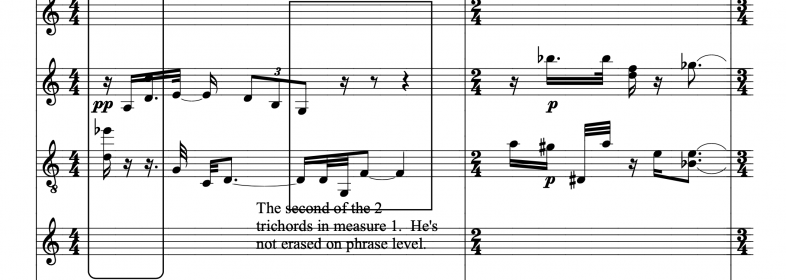Rhythm Falling out from Rhyme & Meter
A more detailed answer to a question that came up at Laura Schwendinger's class at UW-Madison, last Wednesday. Very grateful to have the opportunity to think about this.
I am the anti-Leibowitz.
--First, I must declare that many of my favorite people, many of my favorite composers are committed to vers libre.--
Today, musical phrases are usually not constructed of 4-bar units; and phrase endings often do not rhyme. This is the musical equivalent of vers libre. It's accepted and acceptable, even favored. Before 1918 4-bar phrases with phrase endings that rhyme were the norm.
Schoenberg's 12-tone music returns to First Viennese School phrase rhythms and rhymes. This offended Leibowitz and Boulez. Rejecting Schoenberg they called for something tantamount to vers libre. Specifically, they called for 12 tones with equal weight. Equal weight is something Schoenberg never espoused. The emphasis on equal weight came to dominate Darmstadt aesthetics. It seems to persist at IRCAM also.
Milton Babbitt called himself a Schoenbergian. We see this in his approach to pitch exploring combinatoriality, but also in his very interesting approach to phrase rhythms and rhymes. The opening of Swan Song #1 provides great examples. What Babbitt kept from Schoenberg & Haydn he made his own through his time points. His time point process was a fancy approach to rhyme and meter.
Here is a simple rhythmic scheme. The phrase endings have a simple rhythmic profile that return every 4 bars--

The mid phrase rhythms can be very tightly related to the landing figure and the rhythms into the landing figure. The mid phrase syncopates until the landing, which is an un-syncopation.
Meter and rhyme are suggestive of how a piece grows. Pointing to chord #2 is the first foreboding, the first indication that the piece is up to something on the phrase level. How chord #2 differs from chord #1 portends another kind of development.
The example compresses processes that could unfold over twice as many bars or more.
I no longer care about how consonant or dissonant the harmonies are in these processes. Traditional phrasings start to reconstruct traditional proportions. I call them "bourgeois proportions", meaning no sleight because I am tired of vers libre and equal weight.
Babbitt and Anderson Examples
In my Various Roses, a tune associated with roses is the landing tune/harmony. If you recognize the tune, you're also marking a landing back in an 0 harmony and an 0 rhythm.
My love for Djuna Barnes relates to my penchant for rhyme & meter. Barnes always employs rhyme and meter because she is unwording as much as she is wording.
Here, in my setting of "Seen from the L", the endings of the stanzas get a characteristic rhythmic treatment--the harmony/tune evolves from pentatonic to Balinese pentatonic--
I'm happy with the one melisma on "bloom" it happens in a phrase in which the gamut of harmonies that govern the entire song cycle are heard in order of their intensity. The gamut is all pairs of perfect consonances.
Wonderful rhymes and internal rhymes in Babbitt's Swan Song No. 1.

The triplet in bar 1 gets blown up into a quarter note triplet in bar. It feels monumental--it's at 1:28 in the recording, linked below on Spotify.
The F naturals at the end of bar 2 begins the passage through the complement, very syncopated. Somehow it projects suspension until the landing on the mandolin triplet in bar 3. Never mind that the triplet is syncopated--


The guitar triplet in 6 is the next landing place. Bar 5 is a rythmic foil for the landing in bar 6. That triplet in bar 6 rhymes with the mandolin triplet in bar 4.
At 1:28 listen to the first quarter note triplet. It's a watershed moment, the big event of the opening, and amplification of the guitar's triplet in bar 1.
https://open.spotify.com/track/5JiXFJUw6HOX1vlyv1jkHG?si=kgKToJRrSdO9tcojbs8I_Q

